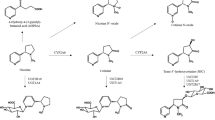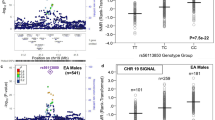Abstract
We investigated polymorphisms of cytochrome P450 2A6 (CYP2A6) and its association with smoking habits in 412 healthy Brazilians, self-recognized as white (n=147), black (n=123) and intermediate (n=142), and classified as smokers (n=205, including 61 ex-smokers) and nonsmokers (n=207). The frequencies of the variant alleles CYP2A6*1B, CYP2A6*2, CYP2A6*4 and CYP2A6*9 in the overall study population were 29.9, 1.7, 0.5 and 5.7%, respectively. Significant differences in the CYP2A6 allelic distribution were observed across the three population subgroups. There was a statistically significant trend for decreasing frequency of CYP2A6*1B from white to intermediate and to black persons. An association between CYP2A6 genotype and smoking dependence was detected, which could not be explained by the expected phenotypic activity of CYP2A6. In white and intermediate persons, the odds ratio (OR) of being smokers vs nonsmokers was 0.07 (95% CI 0.02–0.20; P<0.001) and 0.27 (95% CI 0.12–0.61; P<0.001), respectively, for genotypes including allele CYP2A6*1B, as compared to wild-type homozygous. In contrast, the corresponding OR in black Brazilians was 1.34 (95% CI 0.57–3.17; P=0.46). These data suggest that the CYP2A6*1B is associated with smoking dependence in white and intermediate, but not black Brazilians.
This is a preview of subscription content, access via your institution
Access options
Subscribe to this journal
Receive 6 print issues and online access
$259.00 per year
only $43.17 per issue
Buy this article
- Purchase on Springer Link
- Instant access to full article PDF
Prices may be subject to local taxes which are calculated during checkout
Similar content being viewed by others
References
World Health Organization (WHO). Website: http://www.who.int/dg/speeches/2003/bressels/en date accessed: February 4, 2004.
Carmeli D, Swan GE, Robinette D, Fabsitz R . Genetic influence on smoking—a study of male twins. N Engl J Med 1992; 327: 829–833.
Edwards KL, Austin MA, Jarvik GP . Evidences for genetic influences on smoking in adult women twins. Clin Genet 1995; 47: 236–244.
True WR, Heath AC, Scherrer JF, Waterman B, Goldberg J, Lin N et al. Genetic and environmental contributions to smoking. Addiction 1997; 92: 1277–1287.
Arinami T, Ishiguro H, Onaivi E . Polymorphisms in genes involved in neurotransmission in relation to smoking. Eur J Pharmacol 2000; 410: 215–226.
Tyndale RF, Sellers EM . Genetic variation in CYP2A6-mediated nicotine metabolism alters smoking behavior. Ther Drug Monit 2002; 24: 163–171.
Benowitz NL . Drug therapy—pharmacologic aspects of cigarette smoking and nicotine addiction. N Engl J Med 1988; 17: 1318–1330.
McMorrow MJ, Foxx RM . Nicotine's role in smoking: an analysis of nicotine regulation. Psychol Bull 1983; 93: 302–327.
Flammang AM, Gelboin HV, Aoyama T, Gonzalez FJ, McCoy GD . Nicotine metabolism by cDNA expressed human cytochrome P450s. Biochem Arch 1992; 8: 1–8.
Nakajima M, Yamamoto T, Nunoya K, Yokoi T, Nagashima K, Inoue K et al. Role of human cytochrome P4502A6 in C-oxidation of nicotine. Drug Metab Dispos 1996; 24: 1212–1217.
Messina ES, Tyndale RF, Sellers EM . A major role for CYP2A6 in nicotine C-oxidation by human liver microsomes. J Pharmacol Exp Ther 1997; 282: 1608–1614.
Nakajima M, Yamamoto T, Nunoya KI, Yokoi T, Nagashima K, Inoue K et al. Characterization of CYP2A6 involved in 3′-hydroxylation of cotinine in human liver microsomes. J Pharmacol Exp Ther 1996; 277: 1010–1015.
Cytochrome P450 (CYP). Allele Database. Website: http://www.imm.ki.se/CYPalleles/CYP2A6.htm, date accessed: May 5, 2004.
Rao Y, Hoffmann E, Zia M, Bodin L, Zeman M, Sellers EM et al. Duplications and defects in the CYP2A6 gene: identification, genotyping, and in vivo effects on smoking. Mol Pharmacol 2000; 58: 747–755.
Gu DF, Hinks LJ, Morton NE, Day INM . The use of long PCR to confirm three common alleles at the CYP2A6 locus and the relationship between genotype and smoking habit. Ann Hum Genet 2000; 64: 383–390.
Ariyoshi N, Miyamoto M, Umetsu Y, Kunitoh H, Dosaka-Akita H, Sawamura Y et al. Genetic polymorphism of CYP2A6 gene and tobacco-induced lung cancer risk in male smokers. Cancer Epidemiol Biomarkers Prev 2002; 11: 890–894.
London SJ, Idle JR, Daly AK, Coetzee GA . Genetic variation of CYP2A6, smoking, and risk of cancer. Lancet 1999; 353: 898–899.
Loriot MA, Rebuissou S, Oscarson M, Cenée S, Miyamoto M, Ariyoshi N et al. Genetic polymorphisms of cytochrome P450 2A6 in a case–control study on lung cancer in a French population. Pharmacogenetics 2001; 11: 39–44.
Xu C, Goodz S, Sellers EM, Tyndale RF . CYP2A6 genetic variation and potential consequences. Adv Drug Deliver Rev 2002; 54: 1245–1256.
Oscarson M, McLellan R, Asp V, Ledesma MC, Ruiz MLB, Sinues B et al. Characterization of a novel CYP2A7/CYP2A6 hybrid allele (CYP2A6*12) that causes reduced CYP2A6 activity. Hum Mut 2002; 20: 275–283.
Kiyotani K, Fujieda M, Yamazaki H, Shimada T, Guengerich FP, Parkinson A et al. Twenty one novel single nucleotide polymorphisms (SNPs) of the CYP2A6 gene in Japanese and Caucasians. Drug Metab Pharmacokinet 2002; 17: 482–487.
Nakajima M, Yoshida R, Fukami T, McLeod HL, Yokoi T . Novel human CYP2A6 alleles confound gene deletion analysis. FEBS Lett 2004; 569: 75–81.
Instituto Brasileiro de Geografia e Estatística http://www.ibge.gov.br/home/estatistica/populacao/censo2000/populacao/ date accessed: February 4, 2004.
Parra FC, Amado RC, Lambertucci JR, Rocha J, Antunes CM, Pena SDJ . Color and genomic ancestry in Brazilians. Proc Natl Acad Sci USA 2003; 100: 177–182.
Vianna-Jorge R, Perini JA, Rondinelli E, Suarez-Kurtz G . CYP2C9 genotypes and the pharmacokinetics of tenoxicam in Brazilians. Clin Pharmacol Ther 2004; 76: 18–26.
Goodz SD, Tyndale RF . Genotyping human CYP2A6 variants. Methods Enzymol 2002; 357: 59–69.
Schoedel KA, Hoffmann EB, Rao Y, Sellers EM, Tyndale RF . Ethnic variation in CYP2A6 and association of genetically slow nicotine metabolism and smoking in adult Caucasians. Pharmacogenetics 2004; 14: 615–626.
Pitarque M, Richter OV, Rodríguez-Antona C, Wang J, Oscarson M, Ingelman-Sundberg M . A nicotine C-oxidase gene (CYP2A6) polymorphism important for promoter activity. Hum Mutat 2004; 23: 258–266.
Freeman GH, Halton JH . Note on an exact treatment of contingency, goodness-of-fit and other problems of significance. Biometrika 1951; 38: 141–149.
Salzano FM, Freire-Maia N . Problems in Human Biology—A Study of Brazilian Populations. Wayne State University Press: Detroit 1970.
Alves-Silva J, da Silva Santos M, Guimaraes PE, Ferreira AC, Bandelt HJ, Pena SD et al. The ancestry of Brazilian mtDNA lineages. Am J Hum Genet 2000; 67: 444–461.
Sans M . Admixture studies in Latin America: from the 20th to the 21st century. Hum Biol 2000; 72: 155–177.
Dornelles CL, Callegari-Jacques SM, Robinson WM, Weimer TA, Franco MHLP, Hickmann AC et al. Genetics, surnames, grandparents' nationalities and ethnic admixture in Southern Brazil: Do the patterns of variation coincide? Genet Mol Biol 1999; 22: 151–161.
Krieger H, Morton NE, Mi MP, Azevedo E, Freire-Maia A, Yasuda N . Racial admixture in north-eastern Brazil. Ann Hum Genet 1965; 29: 113–125.
Bamshad M, Wooding S, Salisbury BA, Stephens JC . Deconstructing the relationship between genetics and race. Nat Rev Genet 2004; 5: 598–609.
Yoshida R, Nakajima M, Nishimura K, Tokudome S, Kwon JT, Yokoi T . Effects of polymorphism in promoter region of human CYP2A6 gene (CYP2A6*9) on expression level of messenger ribonucleic acid and enzymatic activity in vivo and in vitro. Clin Pharmacol Ther 2003; 74: 69–76.
Yoshida R, Nakajima M, Watanabe Y, Kwon JT, Yokoi T . Genetic polymorphisms in human CYP2A6 gene causing impaired nicotine metabolism. Br J Clin Pharmacol 2002; 54: 511–517.
Pitarque M, von Richter O, Rodriguez-Antona C, Wang J, Oscarson M, Ingelman-Sundberg M . A nicotine C-oxidase gene (CYP2A6) polymorphism important for promoter activity. Hum Mutat 2004; 23: 258–266.
Yamazaki H, Inui Y, Yun CH, Guengerich FP, Shimada T . Cytochrome P450 2E1 and 2A6 enzymes as major catalysts for metabolic activation of N-nitrosodialkylamines and tobacco-related nitrosamines in human liver microsomes. Carcinogenesis 1992; 13: 1789–1794.
Kamataki T, Nunoya K, Sakai Y, Kushida H, Fujita K . Genetic polymorphism of CYP2A6 in relation to cancer. Mutat Res 1999; 428: 125–130.
Topcu Z, Chiba I, Fujieda M, Shibata T, Ariyoshi N, Yamazaki H et al. CYP2A6 gene deletion reduces oral cancer risk in betel quid chewers in Sri Lanka. Carcinogenesis 2002; 23: 595–598.
Miyamoto M, Umetsu Y, Doska-Akita H, Sawamura Y, Yokota J, Kunitoh H et al. CYP2A6 gene deletion reduces susceptibility to lung cancer. Biochem Biophys Res Commun 1999; 261: 658–660.
Acknowledgements
We are grateful to Dr Rachel Tyndale from the University of Toronto for the gift of control DNAs and for a careful review of the original manuscript. Gisele Vasconcelos is especially grateful to Dr Tyndale and Ms Ewa Hoffmann for the training in CYP2A6 genotyping at the University of Toronto. We thank Dr Etel Gimba for help with genotyping procedures in the initial phases of this work, our colleagues from INCAs smoking cessation programs and Blood Bank for providing the blood samples, and Mr Vitor Hugo Maia for technical assistance. CJ Struchiner and G Suarez-Kurtz are Senior Investigators of Conselho Nacional de Desenvolvimento Científico and Tecnológico (CNPq), and work in their laboratories is supported by grants from CNPq, Swissbridge Foundation, Fundação Ary Frauzino and Fundação de Amparo à Pesquisa do Estado do Rio de Janeiro (FAPERJ).
Author information
Authors and Affiliations
Corresponding author
Rights and permissions
About this article
Cite this article
Vasconcelos, G., Struchiner, C. & Suarez-Kurtz, G. CYP2A6 genetic polymorphisms and correlation with smoking status in Brazilians. Pharmacogenomics J 5, 42–48 (2005). https://doi.org/10.1038/sj.tpj.6500290
Received:
Revised:
Accepted:
Published:
Issue Date:
DOI: https://doi.org/10.1038/sj.tpj.6500290
Keywords
This article is cited by
-
Association of genetic polymorphisms CYP2A6*2 rs1801272 and CYP2A6*9 rs28399433 with tobacco-induced lung Cancer: case-control study in an Egyptian population
BMC Cancer (2018)
-
CYP2A6 deletion polymorphism is associated with decreased susceptibility of lung cancer in Asian smokers: a meta-analysis
Tumor Biology (2013)
-
In vivo evaluation of CYP2A6 and xanthine oxidase enzyme activities in the Serbian population
European Journal of Clinical Pharmacology (2010)
-
Identification of Novel CYP2A6*1B Variants: The CYP2A6*1B Allele is Associated With Faster In Vivo Nicotine Metabolism
Clinical Pharmacology & Therapeutics (2008)
-
Association of CYP2A6*1B genetic variant with the amount of smoking in French adults from the Stanislas cohort
The Pharmacogenomics Journal (2005)



